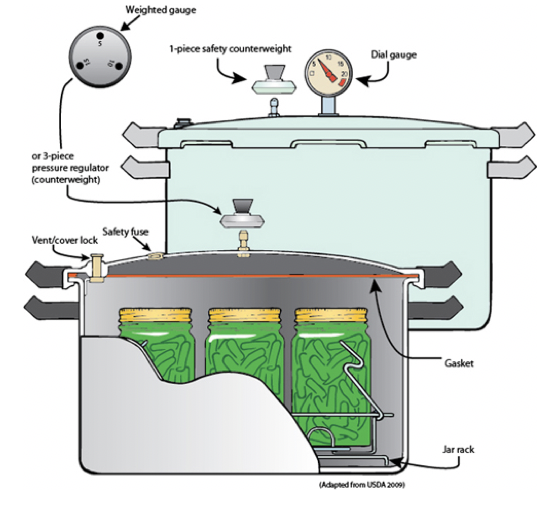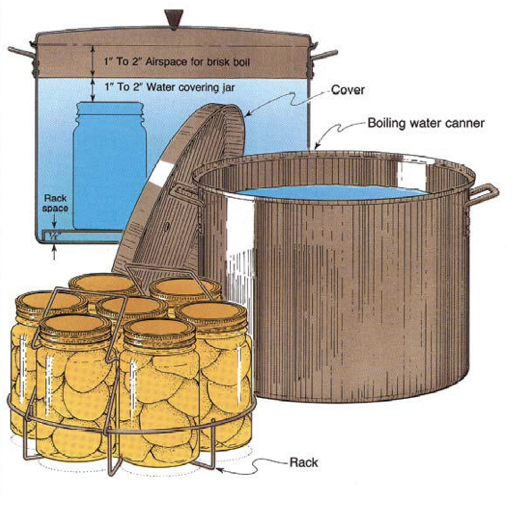Home Canning: The Basics
go.ncsu.edu/readext?671675
en Español / em Português
El inglés es el idioma de control de esta página. En la medida en que haya algún conflicto entre la traducción al inglés y la traducción, el inglés prevalece.
Al hacer clic en el enlace de traducción se activa un servicio de traducción gratuito para convertir la página al español. Al igual que con cualquier traducción por Internet, la conversión no es sensible al contexto y puede que no traduzca el texto en su significado original. NC State Extension no garantiza la exactitud del texto traducido. Por favor, tenga en cuenta que algunas aplicaciones y/o servicios pueden no funcionar como se espera cuando se traducen.
Português
Inglês é o idioma de controle desta página. Na medida que haja algum conflito entre o texto original em Inglês e a tradução, o Inglês prevalece.
Ao clicar no link de tradução, um serviço gratuito de tradução será ativado para converter a página para o Português. Como em qualquer tradução pela internet, a conversão não é sensivel ao contexto e pode não ocorrer a tradução para o significado orginal. O serviço de Extensão da Carolina do Norte (NC State Extension) não garante a exatidão do texto traduzido. Por favor, observe que algumas funções ou serviços podem não funcionar como esperado após a tradução.
English
English is the controlling language of this page. To the extent there is any conflict between the English text and the translation, English controls.
Clicking on the translation link activates a free translation service to convert the page to Spanish. As with any Internet translation, the conversion is not context-sensitive and may not translate the text to its original meaning. NC State Extension does not guarantee the accuracy of the translated text. Please note that some applications and/or services may not function as expected when translated.
Collapse ▲Home canning is a great way to save fresh foods to eat year-round. The history of canning dates back to as early as 1809 when Nicolas Appert developed a method of preserving food in airtight glass jars. Over the years canning has evolved which is why it’s very important to follow scientifically tested recipes to ensure safe home processing. The National Center for Home Food Preservation is one of the best sources for current research-based information.
Whether you are new to canning or experienced it’s always helpful to brush up on the instructions each year. Click here for general canning information (safety, choosing jars and lids, troubleshooting, etc.).
Methods of Canning
Pressure Canning
Pressure canning is mainly used for low acid foods and some high acid foods. Pressure canning low acid food is essential in order to kill C. Botulinum (botulism) spores. Pressure canners heat to at least 240 degrees F to destroy pathogens and prevent spoilage.

See Pressure Canning publication from the National Center for Home Food Preservation
Examples of Low Acid Foods (pH above 4.6)
Most vegetables
- Asparagus
- Beets
- Carrots
- Green and dried beans
- Okra
- Peas
- Peppers
- Potatoes
- Pumpkin
- Sweet corn
Meats
- Beef and Poultry
- Mincemeat pie filling
- Seafood
- Wild game
Combination Foods
- Meat sauces
- Soups and stews
Water Bath Canning
For safety this method should be used for high acid foods only, the acid in the food kills botulism spores. Water must be heated to boiling (212 degrees F) in order to destroy pathogens and prevent spoilage.
See Water Bath Canning publication from the National Center for Home Food Preservation
Examples of High-Acid Foods (pH equal to or below 4.6)
Most fruits
- Apples and apple sauce
- Apricots
- Berries
- Cherries
- Grapes
- Jams and jellies (fruit only)
- Peppers
- Peaches and nectarines
- Pears
- Pie fillings (fruit only)
- Plums
Acidified and fermented foods
- Chutney
- Pickled vegetables
- Pickles (cucumbers)
- Relishes
- Salsa
- Sauerkraut
- Tomatoes (acidified)
A word of caution…
There can be a lot of misinformation regarding canning practices, and outdated methods that could lead to food spoilage and allow the growth of clostridium botulinum (an illness that can result in death). The following canning methods are not recommended by Cooperative Extension research.
- Pressure cookers
- Electric saucepans
- Open kettle method (putting hot food into jars and letting them self seal).
- Microwaves
- Dishwashers
- Instant pot
- Oven canning
For more home food preservation information contact your local Cooperative Extension Center.




